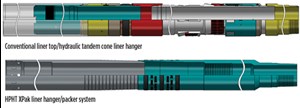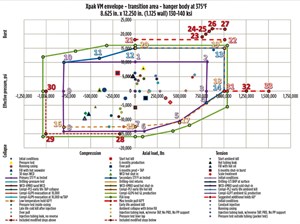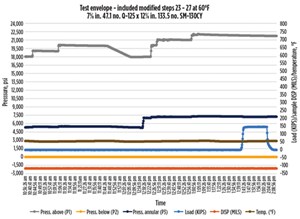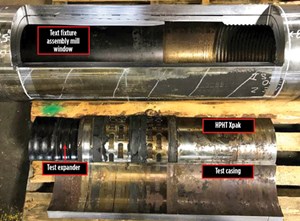HPHT expandable liner hanger designed for superior pressure integrity
Companies working in deep water are encountering difficult high-pressure and high-temperature (HPHT) conditions. Well construction designs that achieve robust structural stability and possess the pressure integrity required to reach these depths, using drilling and production casing strings, have evolved with the availability of heavy wall tubular products. Operators are searching for liner accessories to provide anchoring and sealing capability, with performance ratings that meet or exceed that of the host casing and the drilling or production liner. The hanger/packer system is a critical component of the casing string, which must provide burst and collapse resistance, and handle loading conditions during various well operations while mitigating the effects of thermal and fatigue cycling.
EXPANDABLE VS CONVENTIONAL
Expandable technology provides an alternative to conventional liner hanger/packer systems, which typically utilize slips and cone components configured on the outer diameter (OD) of a hanger body. The set-up requires translation of the slips onto the cone for installation
of the liner hanger in the host casing. Conventional liner top packer systems typically require drillstring weight for the mechanical force required to energize a sealing element that produces the annular seal between the liner and host casing strings.
Conversely, expandable liner hanger/packer technology has gained market share in recent years, after an increase in successful field installations. Expandable liner hanger/packers consist of an integral hanger body design that incorporates elastomeric sealing elements normally bonded on the OD. Hanger body expansion into the host casing is accomplished with the application of hydraulic pressure through a setting tool to create enough force to displace an anvil through the hanger body inner diameter (ID). Interference between the hanger body ID and the anvil OD creates the interaction necessary for the creation of radial growth required to facilitate interference with the host casing. The anvil is retrieved with the running tool from the well after the expandable hanger body has been installed.
HPHT XPak expandable liner hanger. The company’s HPHT expandable liner/packer system differs from other expandable products by propagating expansion using an expander, a tubular component with a distinctive OD profile, Fig. 1. The expander is displaced with an interference fit inside the integral hanger body to create the expansion needed to anchor and seal to the host casing. A multi-piston hydraulic running tool, with pressure activation initiated by liner wiper plug displacement during cementing or a setting ball dropped from the surface, applies force to displace the expander and carries the liner downhole. The expander is permanently installed inside the HPHT XPak hanger body.
The contact pressure generated during the expansion process is preserved, which ensures an installation that is superior in anchoring ability and provides the added benefit of high collapse resistance from annular pressure. Multiple segmented slips are installed and retained in machined pockets oriented on the circumference of the hanger body. A proprietary process is applied to the slip surface to ensure hardness capable of penetrating the host casing for anchoring capability.
Elastomeric sealing elements are installed on the hanger body’s OD, bordered by metal seal ribs. The combination of metal and elastomer sealing elements provide redundancy for ensuring pressure integrity at the liner top. The metal seal ribs also provide additional anchoring capability from the contact pressure generated during expansion by interaction with the host casing’s ID.
OPERATIONAL BENEFITS
The HPHT expandable liner hanger/packer system has fewer external components, increased annular flow area for fluid circulation and field-proven sealing/anchoring technology. The HPHT liner hanger is compatible with all host casing types and provides comparable performance as an accessory for use in drilling and production intervals. Ease of system installation, with simple operating parameters to reduce the time necessary for setting, testing and releasing from a newly deposited casing string, are advantages that help operators reduce costs. Several companies have shown broad global interest in adopting this technology, because of its potential to improve well construction safety, reduce environmental risk, and cut costs by reducing NPT and remedial activities.
EXPANDABLE LINER HANGER CONCEPT
The expansion of a steel tube (hanger body) requires driving a cone-shaped mandrel (expander) into its ID with substantial force. The expansion causes high stresses in the expander and the hanger body. These high stresses often exceed the yield strength of the expander, and always exceed that of the hanger body. This is contrary to traditional design practices, where design loads are never intended to go beyond their material yield strength. These traditional designs keep the product in the elastic region of the material and allow the material to return to its original shape when the loads are removed. For example, if a string of tubing was exposed to external pressure that exceeded its yield strength and was then removed, the passage of plugs or other equipment might not be possible, and lead to drift problems.
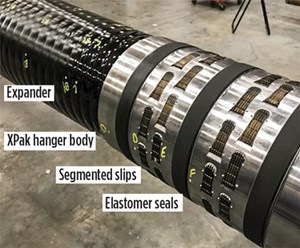
When the expansion process is complete, a partially expanded transition region exists within the hanger. This region can be subjected to tension and compression loads, along with combined burst and collapse pressures. There are no known formulas to predict the rating of the transition region, since it has both elastic and plastic properties. Therefore, the design stage requires that finite element analysis (FEA) be used to predict performance and ensure ratings obtained are conservative with adequate safety factors. FEA simulations are used to determine the force required to expand, the resulting deflections, and provide a complete view of the stresses and strains throughout the model. Since the expansion of the hanger body causes its stresses to exceed the yield strength, focus is applied on the strain instead of the stress to determine if the design can withstand the applied loads.
The fracture strain value (% elongation) of the chosen material is obtained from material testing and can be examined against the FEA results to predict suitability to the operator’s environment. Tensile and burst predictions are closely related to laboratory tests. Compression and collapse, however, are subjected to the Baushinger Effect, where an increase in tensile yield strength occurs at the expense of compressive yield strength. Unlike other expandable liner hanger systems, the HPHT XPak liner hanger system retains the expanding mandrel (expander) after installation, which supports the transition region in collapse and protects against reduced strengths caused by the Baushinger Effect. Qualification testing of XPak technologies has enabled us to create operating envelopes that coincide with our FEA predictions.
HPHT DESIGN
The design concept for HPHT applications required the knowledge gained from performance improvements achieved during previous qualification tests on the XPak expandable product line to conceive a system that would meet the operator’s requirements. Many design iterations were performed, and a four-phase validation plan was executed, to develop the optimal expandable liner hanger/packer system with the setting force required for expansion in the prescribed well conditions and environment. Conceptual feasibility design, detailed design validation, prototype testing and manufacturing for well development were all considered and completed to meet the customer’s requirements. Each feature of the HPHT liner hanger/packer system was designed for well conditions and operator safety requirements that were more severe in scope than those required for previous XPak designs.
Liner and casing dimensional data and performance ratings are listed in Table 1. The information provides insight into the expandable liner hanger/packer system design that is required to interface between the two tubular casing strings utilized in this deepwater well design.
HPHT DESIGN VALIDATION
Finite element analysis is the required method for evaluating the XPak and HPHT XPak liner hanger/packer designs for simulating applied pressures and well loading conditions. Material models, developed through material testing at ambient and elevated temperatures, are utilized as input in the modeling software to best represent the materials used for construction of the prototype. Two-dimensional modeling was used to determine the setting force required to displace the expander into the HPHT hanger body, while the resultant stress and strain levels within the expander, hanger body and host casing after expansion are reviewed for compliance with governing design standards. Tension and compression loads applied to the hanger system with the application of internal and external pressure are analyzed to determine if contact pressure generated from expansion is adequate to keep the system anchored in the host casing.
HPHT QUALIFICATION TESTING
The testing plan for product qualification of the HPHT liner hanger/packer system was created to satisfy two separate drilling groups employed by the same operator, Fig. 2. The engineers reviewed the expandable liner hanger design and performance ratings to determine whether the system could be utilized for injection and production well designs. The potential for use in both applications resulted in the creation of a test matrix with minimum and maximum testing temperatures of 60°F and 375°F, respectively.
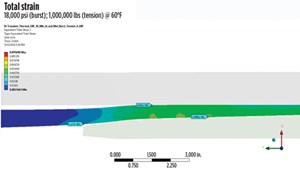
Dimensional inspections of the expander, HPHT liner hanger/packer and test casing specimen were performed to note the pre-expansion measurements for comparison with post-expansion dimensions. The data comparison review, post-test, was used to validate the FEA results achieved through simulation of the testing conditions applied, Fig. 3.
Expansion of the HPHT liner hanger/packer into operator-supplied casing was achieved by utilizing a multi-piston, hydraulic setting tool at the operator’s test facility. The expanded hanger system test assembly was outfitted with heating coils, thermocouples and pressure transducers to induce heat, record temperature and pressure, respectively. Pressure (5,000 psi) was applied to the setting tool using a tri-plex pump with water as the test media, generating the force required for full displacement of the expander inside the HPHT hanger body. This expanded and anchored the hanger system in the test casing. After expansion, the setting tool was extracted from the expanded hanger for assembly of the qualification test fixture to commence.
The qualification test fixture was comprised of the expanded sub assembly and an outer, heavy-walled tubular sleeve to allow pressure application to the annulus of the test casing. Prescribed high burst testing pressures applied to the operator’s casing necessitated the use of annular pressure for compensation to maintain safe testing conditions. The HPHT test fixture was installed into a third-party load frame designated by the operator to conduct the 33 tests labeled on the testing envelope, Fig. 4.
Temperature cycle testing from 60°F to 375°F with 15 ksi applied, both internally and externally, and pressure reversals at the maximum specified temperature were achieved successfully. All testing results were acceptable, based on ISO14310/API 11D1 standards of zero bubbles detected during 15-min. hold periods.
The first phase of envelope testing (tests 1 to 20) with internal pressure and external pressure holds at 15 ksi and 14 ksi, respectively, were achieved with no leakage of nitrogen gas communicating across the HPHT liner hanger/packer’s metal and elastomeric seals. Maximum tension and compression loading from a combination of pressure induced and mechanical force application, of 1,000 kips and 800 kips, respectively, were achieved at the maximum pressures and temperature noted.
After obtaining successful results from the first testing phase, additional, operator-prescribed load points, noted as tests 21 to 33, were performed at 60°F. Successful hold points were achieved at burst pressures of 18, 19, 20 and 21.75 ksi, and a maximum collapse pressure of 15 ksi. Additional tension load testing (tests 31 to 33) was achieved successfully to a maximum value of 1,500 kips without pressure application. Figure 5 displays performance of the HPHT liner hanger/packer system as burst pressure (internal pressure) was increased from 18 ksi to 21.75 ksi with captured values for temperature, displacement, annular pressure (required to maintain safe test casing differential pressure rating), load and pressure below monitored for leakage.
HPHT POST-TEST ANALYSIS
A drift test was performed on the HPHT liner hanger/packer system, once the qualification testing fixture was disassembled. Translation of the drift bar through the expander and hanger body, with no interference, verified the inner diameters through both entities were not restricted and/or compromised from applications of setting force during the expansion set sequence and annular test pressure during qualification. Outer diameter measurements of the test casing were performed and compared, pre- and post-expansion, for a diametrical difference of 0.011-in. The test sub-assembly, consisting of the expander, HPHT liner hanger/packer and test casing, was strategically machined, using a milling operation to create a window for analytical review of the components.
The test fixture dissection provided a cross-sectional view of the installed hanger system with reassurance of the setting distance achieved, slip penetration depth, system displacement, metal and elastomer seal engagement, surface condition between the expander’s OD and the hanger body’s seal bore diameter. A review of the milled test specimen (Fig. 6) revealed excellent slip penetration, with negligible movement of the system during test, distinguishable impressions from metal seal rib and elastomer contact with the casing and mild wear (no deterioration from galling) of the expander and hanger body surfaces.
HPHT TECHNOLOGY ADVANTAGE
The HPHT XPak is a premium expandable liner hanger system that offers superior sealing and anchoring capability for drilling and production casing installations. The expandable liner hanger, with its integral barrel design comprised of liner running tool thread, metal seal ribs, elastomer seal bands, bi-directional segmented slips and premium connection option, is an excellent equipment choice for HPHT environments. Optimizing liner running speed is possible, with an increase in annular bypass area gained from the expandable hanger body’s major diameter, compared to conventional liner hanger systems. Expandable liner hanger system installation is accomplished with a multi-piston, hydraulic setting tool, with pressure activation initiated either by the liner wiper plug system bump during cementing displacement or setting ball drop into a designated seat within the tool.
All XPak expandable liner hanger systems, including HPHT versions, are designed with guidelines to ensure that performance ratings derived, using FEA modeling, are conservative with adequate safety factors. FEA simulations involve multiple iterations to test parameters, which ultimately make each expandable design custom for the liner size, weight, grade, casing size, weight and grade. This design approach allows for the creation of a high-performance expandable liner hanger with a history of validation through extensive qualification testing and field-proven success globally.
Qualification testing of the 7.625-in. liner hanger/packer system was accomplished successfully through a rigorous set of loading conditions prescribed by a major global operator. Test steps were derived from a performance envelope generated with a conservative design approach, based on FEA results. Load points achieved successfully outside of the performance envelope provided evidence of the safety factors utilized to assess capability. Maximum internal and external pressures, which were applied and successfully held during qualification testing, were 121% and 80%, respectively, of the 7.625-in. 47.1# Q-125 liner performance rating.
The HPHT expandable liner hanger/packer system provides operator value through superior sealing/anchoring technology that potentially improves well construction safety, while reducing operational and environmental risks, and mitigating non-productive, remedial activities. Simple operating parameters and liner running speed optimization for system installation are cost-saving attributes that make the system an attractive option for extreme, deepwater environments. WO
- Developing an F22, umbilical-compatible scale inhibitor for West Africa (November 2022)
- Natural gas-powered, direct-drive turbine fracturing technology delivers variety of improvements (September 2022)
- Executive Viewpoint: Technology, Technology, Technology (August 2022)
- Subsea trees and the path to standardization (August 2022)
- Engineering simulation can reduce CAPEX and OPEX for fractured shale wells in the Permian basin (July 2022)
- Pump sand protection technology extends ESP run life in unconventional wells (July 2022)
- Applying ultra-deep LWD resistivity technology successfully in a SAGD operation (May 2019)
- Adoption of wireless intelligent completions advances (May 2019)
- Majors double down as takeaway crunch eases (April 2019)
- What’s new in well logging and formation evaluation (April 2019)
- Qualification of a 20,000-psi subsea BOP: A collaborative approach (February 2019)
- ConocoPhillips’ Greg Leveille sees rapid trajectory of technical advancement continuing (February 2019)

